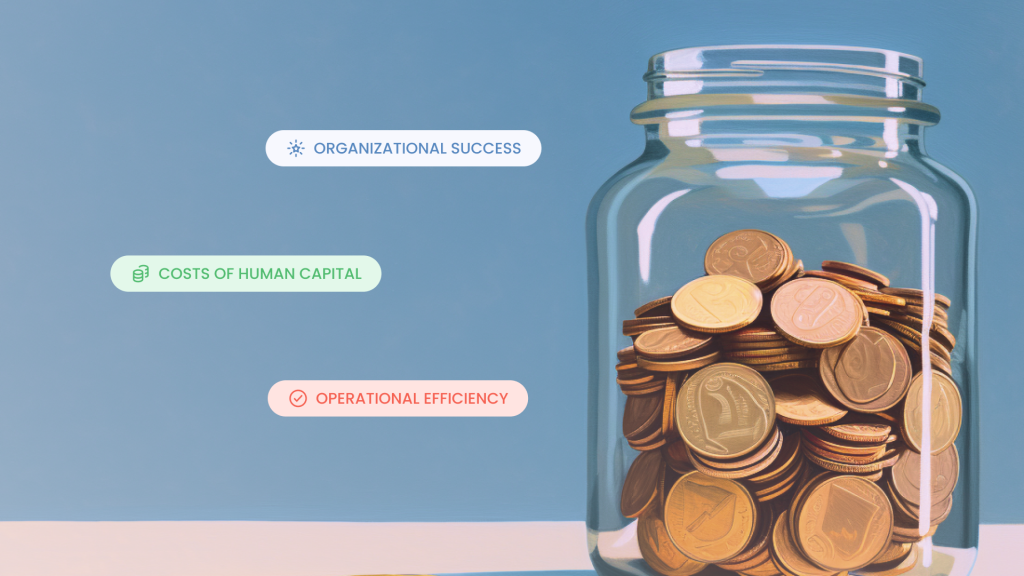Effective Human Resources takes more than just humans—it takes resources too. The best HR teams are well-funded, and equipped with the money they need to invest in the people that ultimately drive organizational success.
But it’s not just about having access to financial support, it’s about how that money is allocated to maximize its impact. That’s where a well-planned HR budget comes in, a firm financial guide that will help you and your team devise where your money is spent, and predict the outcomes it will have.
Here, we’re diving into the nitty gritty of what makes an HR budget more than just a sheet of facts and figures, and instead makes your HR department an essential part of the organization-wide strategy.
What is an HR Budget?
Like all budgets, an HR budget is a financial plan that outlines how a Human Resources department will allocate their resources. It serves as a roadmap for managing the expenses related to all HR functions, and acts as a guide to ensure financial resources are properly distributed to meet all business needs, without overspending.
Expenditures you can expect in an HR budget include employee salaries, recruitment costs, training and development programs, benefits administration, HR technologies, and initiatives aimed at enhancing the overall employee experience.
Crafting an effective HR Budget is essential for aligning HR activities with the broader financial strategy of your organization. Done effectively, it will help create and advance effective workforce and performance management and development.
Why Plan an HR Budget?

While planning a budget doesn’t exactly scream “excitement,” creating a proper HR budget is one of the most strategically significant steps a successful organization can take.
- Managing the costs of human capital — One of the most important functions of an HR budget is to manage the costs associated with the people who work for your organization, sometimes called “human capital”. By carefully forecasting and allocating resources, your HR department can prevent overspending, inefficient allocation of resources, and ensure that your organization invests sufficiently in its most valuable asset—its people. A well-planned HR budget also offers the flexibility to reallocate resources when circumstances change, like when an organization needs to quickly grow its head count.
- Ensuring HR operational efficiency — An HR budget is the guide to follow for resource allocation, providing a comprehensive view of where and how funds will be spent, and what initiatives take priority. This clarity maximizes efficiency and helps HR teams to align their activities with strategic objectives, avoid resource bottlenecks, and streamline processes.
- Achieving organizational success — As all HR professionals know, the success of an organization is directly linked with the effectiveness of its Human Resources. A well-planned HR budget helps you optimize the potential of your workforce, and fosters a culture of productivity, engagement, and continuous improvement, each initiative receiving proper funding as allocated by the HR budget. It also allows you to anticipate and adapt to regulatory changes, helping you stay agile, and future-proof your HR strategy.
- Having a seat at the decision-making table – These days, HR is increasingly expected to be a strategic partner with leadership. In fact, 60% of executives expect HR to become partners in improving a company’s competitive advantage. A well-planned budget is more than a financial document—it’s a key to the decision-making table. By presenting a comprehensive budget plan, HR professionals elevate their role from administrative support to strategic contributor, demonstrating how HR initiatives align with and drive broader organizational objectives. This strategic positioning is crucial as businesses recognize HR’s essential role in driving the overall success of the company.
What to Include in Your HR Budget
Building a comprehensive HR budget involves considering all the areas that directly impact employee well-being and organizational growth. Here’s a breakdown of essential components to consider in your HR budget:
Talent Acquisition & Recruitment: Allocate funds for recruitment efforts, including job postings, recruitment software, and staffing resources. A well-funded talent acquisition strategy ensures a robust pipeline of qualified candidates. When allocating resources for talent acquisition consider—what is the growth trajectory of your company? This is a perfect example of where HRs role can become strategic and forward-thinking.
Learning and Development: Invest in employee growth and skill enhancement programs. Include allocations for training sessions, workshops, and online learning platforms to promote continuous learning within the organization.
HR Upskilling: As technology and industry landscapes evolve, earmark funds for upskilling HR professionals. This ensures that the HR team grows their skillset and can leverage the latest tools and strategies.
HR Technology: Allocate resources for HR technology tools and platforms. This includes HRIS (Human Resource Information System), payroll software, performance management systems, and other technologies that enhance HR efficiency. With the explosion of HR technology available to you, carefully consider which options offer the most value to your organization, and budget accordingly. Also consider the resources required to train your employees on any new technology they need to incorporate into their skillsets.
Compensation and Benefits: Of all budget lines, this one is likely to receive the most scrutiny and interest. Include allocations for employee compensation, benefits packages, and incentives. This encompasses salaries, bonuses, health benefits, retirement plans, and any additional perks that contribute to employee satisfaction and retention. Adequate compensation is incredibly important for keeping talented employees on board, and motivating employees to perform at their best.
Diversity, Equity, and Inclusion: Prioritize diversity, equity, and inclusion initiatives by allocating funds for programs and activities that foster an inclusive workplace culture. This may include diversity training, mentorship programs, and events that celebrate diversity. Initiatives that promote diversity are especially important as Gen Z becomes a major part of the workforce, as shared values are a major motivating factor for them.
Employee Relations and Talent Management: Devote resources to employee relations programs that enhance workplace harmony, such as town halls, social events and skill development opportunities. Also, budget for talent management initiatives such as succession planning, performance reviews, and employee engagement activities.
Employee Safety and Well-being: Make employee health and safety a priority in your HR budget by allocating funds for workplace safety measures, wellness programs, and mental health initiatives. This not only protects your employees but also contributes to a positive work environment, and a workforce that feels safe and respected in their workplace.
HR Administration: Cover essential administrative functions of the HR department, including salaries of HR staff, office supplies, and other day-to-day operational expenses. While not as high profile as other budget lines, having adequate coverage of admin costs is essential to the smooth functioning of an HR department.
Tips to Building an HR Budget

Creating an effective HR budget means delving into strategic planning and developing a thorough understanding of what your organization needs. Having a clear view of how your strategy ladders up to the success of your organization is key when setting up your budget.
Define business goals
The first step of creating an HR budget is aligning it with overarching business goals. If your company aims for rapid growth, allocate resources to talent acquisition and onboarding. If innovation is a key objective, earmark funds for learning and development initiatives to upskill your workforce.
Remember, as an HR professional you’ll have a clearer view of how your workforce will respond to growth and new initiatives, and you have the opportunity to not only understand business objectives, but actually help shape them.
Review previous spending
Next, examine historical spending patterns with a critical eye. Identify areas where resources were well-utilized and those that might need adjustment. For instance, if a particular training program yielded high employee retention, consider expanding it. Alternatively, if surveys indicate an employee engagement initiative or training program is being ineffective or underused, consider reallocating resources to more successful campaigns.
Forecast workforce needs
You can anticipate future talent requirements by understanding the evolving needs of the business. Assess the skills your workforce possesses and those needed for upcoming projects or strategic shifts. This ensures that your budget addresses the organization’s changing dynamics.
Analyze data
Leverage HR analytics for data-driven decision-making. Metrics such as turnover rates, performance metrics, and employee satisfaction scores provide valuable insights. Use this data to pinpoint areas for improvement and allocate resources accordingly. Collecting and analyzing data also helps you make informed strategic recommendations, based on solid information.
Hope for the best, plan for the worst
Even the best laid plans can face disruption. It’s simply impossible to predict everything. That’s why your budget needs to include contingency plans for unexpected challenges. If your budget is contingent on revenue projections, build safeguards for economic downturns. Establishing a financial buffer allows the organization to navigate unforeseen circumstances without compromising HR initiatives.
Consider investments
Evaluate HR initiatives as strategic investments. For instance, if you’re considering HR technology, weigh the potential benefits in terms of time saved, improved accuracy, and enhanced employee experience. Ensure that each investment aligns with your organizational goals. Money spent this year could have positive impacts in years to come if invested wisely now.
Leverage tools
Explore modern HR budgeting tools that automate processes and provide real-time insights. These tools often come with features like predictive analytics, facilitating more accurate forecasting. Integration with other HR systems ensures seamless collaboration and data consistency.
Save On HR Costs Through Automation
HR automation helps save significant time and reduce costs associated with the various manual tasks performed every day by HR and leadership. Studies have shown HR automation can decrease administrative costs by 30% for HR professionals and 49% for employers.
Routine HR workflows, such as data entry, employee onboarding, leave management, and payroll processing, are streamlined and automated, freeing up HR teams to focus on more strategic and value-added activities that drive productivity and profitability for your organization.
What’s more, HR automation tools like Omni provide clear and timely insights into your organization’s spending, helping you build and audit your HR budget backed by real data.
Learn how Omni users like Unravel Carbon save thousands of dollars annually by leveraging HR automation tools. If you’re ready to make that jump and take charge of your HR budget,


